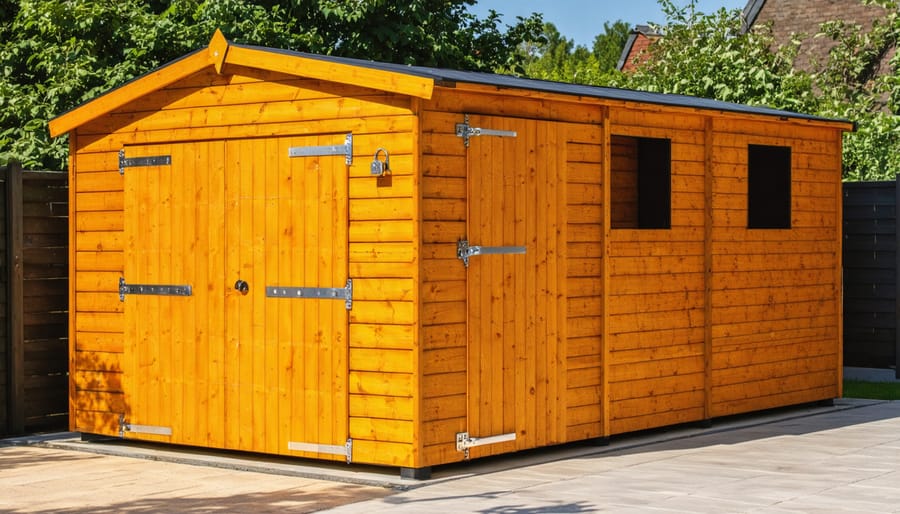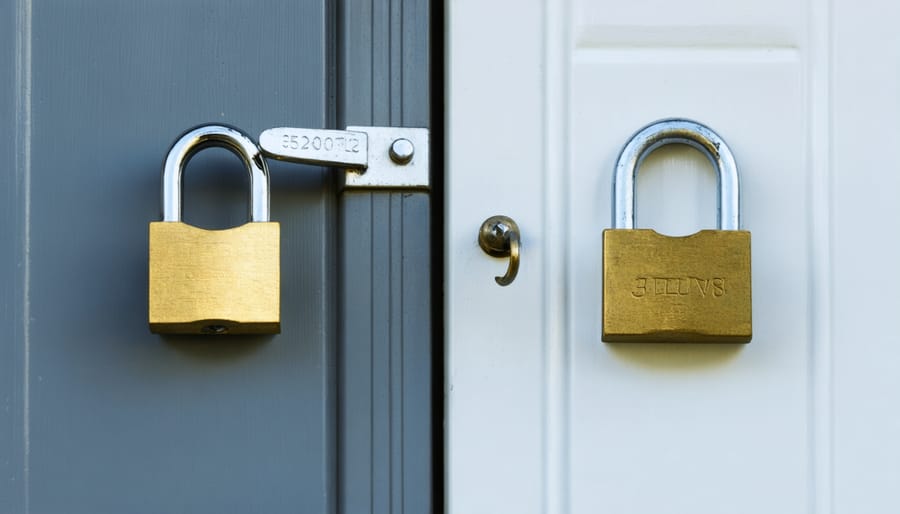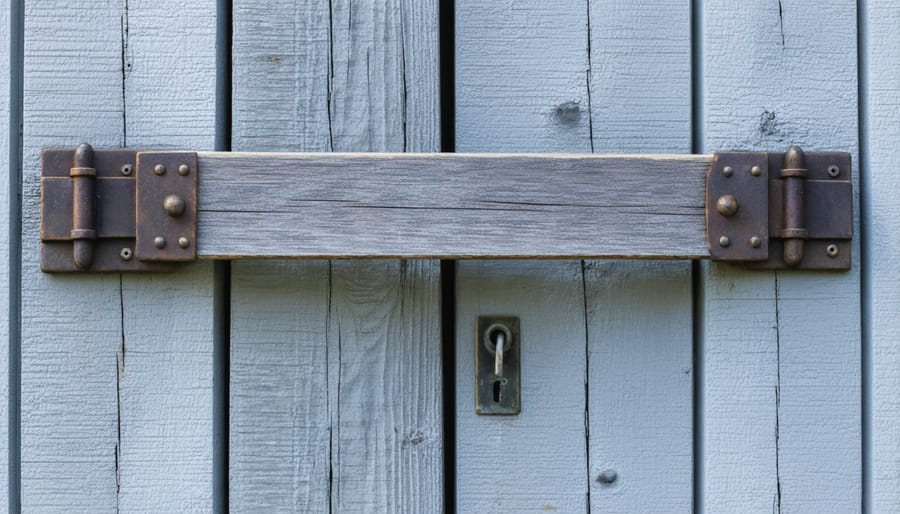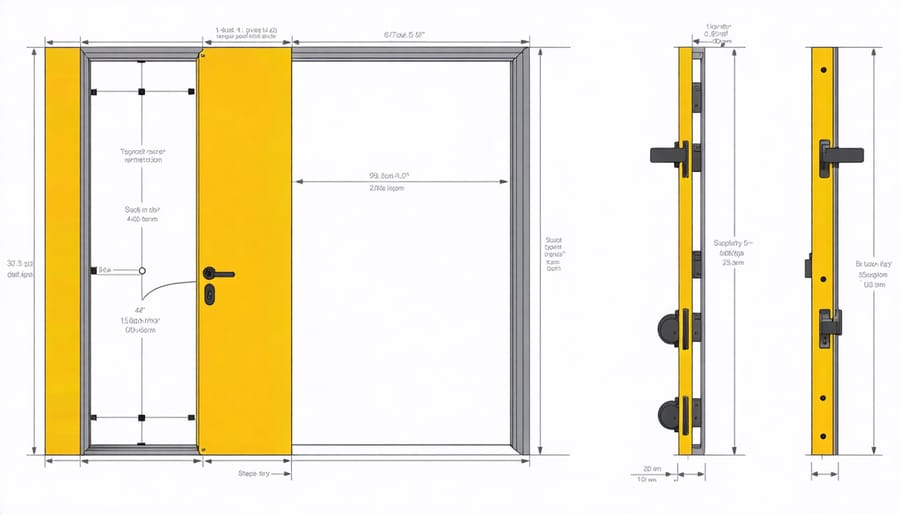Make Your Shed Burglar-Proof: Simple Security Lock Solutions That Actually Work

Secure your outdoor storage with a high-quality padlock rated ASTM Grade 1 or higher, featuring a hardened steel shackle and weather-resistant coating. Install a hasp and staple system with tamper-proof security bolts, ensuring mounting plates are secured from inside the shed for maximum protection. Reinforce door hinges with 3-inch wood screws and add a secondary deadbolt lock for crucial access points. When protecting your shed, combine visible deterrents like motion-sensor lights with concealed security measures such as door reinforcement plates. Choose locks with key-retaining features that prevent leaving the padlock unlocked accidentally, and always maintain a spare key in a secure location away from the shed. This layered security approach creates multiple barriers against theft while maintaining convenient access for daily use.
Why Standard Shed Locks Aren’t Enough
Common Weak Points in Shed Security
Even the most robust lock can’t protect your shed if other vulnerabilities exist. While you work to optimize your shed storage, it’s crucial to address these common weak points that burglars frequently target.
Windows are often the first choice for break-ins, especially if they’re not reinforced or left unlocked. Hinges exposed on the outside of doors present another vulnerability, as they can be easily dismantled. Poor-quality hasps or those installed with short screws can be quickly pried off, rendering your lock useless.
The door frame itself is frequently overlooked but crucial – a weak frame can be forced open regardless of lock quality. Gap spaces under doors or between wall panels provide leverage points for crowbars, while roofing felt joins and corners can be easily cut or pulled apart if not properly secured.
Light fixtures and alarm sensors mounted on weak spots or easily accessible areas may be tampered with, while inadequate lighting around the shed creates opportune conditions for theft attempts.

Best Security Locks for Your Shed
Padlock Systems
When it comes to securing your shed, a high-quality padlock system is your first line of defense. Look for padlocks made from hardened steel with a rating of at least Grade 3 on the ASTM security scale – these offer excellent protection without breaking the bank. Weather-resistant options with protective covers are particularly important for outdoor use, preventing rust and ensuring smooth operation year-round.
Pair your padlock with a heavy-duty hasp for maximum security. Choose a hasp that’s at least 3.5 inches long with a thickness of 1/8 inch or greater. Make sure all mounting hardware is installed from the inside of the shed, preventing would-be thieves from simply unscrewing the hasp. For added protection, consider a shrouded hasp design that covers the padlock’s shackle, making it nearly impossible to cut with bolt cutters.
For valuable equipment storage, invest in a disc padlock system. These specialized locks feature a unique circular design that’s inherently more resistant to cutting and prying. While they cost a bit more, the added security is worth the investment for protecting expensive tools and equipment.
Door Bar Locks
Door bar locks offer robust security for your shed through two main types: cross-bar systems and sliding bolt mechanisms. Cross-bar locks span the entire width of your door, making it extremely difficult for intruders to force entry. These bars typically mount with heavy-duty brackets and can be secured with a padlock for added protection.
Sliding bolt systems, while simpler in design, provide effective security when properly installed. These consist of a sturdy metal bar that slides into a receiving bracket, preventing the door from opening. For maximum security, choose heavy-duty models with hardened steel construction and tamper-resistant mounting hardware.
Many homeowners opt to install both types for enhanced protection. The cross-bar serves as the primary security measure, while the sliding bolt acts as a backup. When installing either system, ensure all mounting hardware penetrates the door frame’s structural supports, not just the shed’s exterior panels.
For optimal security, consider pairing your door bar lock with weatherproof padlocks and reinforced hinges. This creates a comprehensive security system that protects your valuable tools and equipment while maintaining easy access for daily use.

Smart Lock Solutions
Modern smart security solutions have revolutionized shed protection. Bluetooth-enabled locks let you control access through your smartphone, perfect for monitoring who enters your shed and when. Many models offer features like temporary access codes for service providers or neighbors, real-time alerts, and activity logs.
Popular options include keypad locks with backup mechanical keys, fingerprint scanners, and Wi-Fi-connected systems that integrate with your home security setup. Some smart locks even include weather-resistant cameras and motion sensors, adding an extra layer of protection.
Battery life typically lasts 6-12 months, and most systems notify you when power runs low. While these high-tech options cost more than traditional locks, they offer convenience and enhanced security that many homeowners find worthwhile for protecting valuable tools and equipment.
DIY Installation Tips
Tools and Materials Needed
To properly install a secure shed lock, you’ll need several essential tools and materials. Gather a power drill with various drill bits, a screwdriver set (both Phillips and flathead), a pencil for marking, and a measuring tape. Depending on your lock choice, you may also need a hole saw for installing a padlock hasp or deadbolt.
Keep basic hardware on hand, including mounting screws, washers, and anchors appropriate for your shed’s material (wood or metal). For metal sheds, you’ll want self-tapping screws. A level ensures straight installation, while a utility knife helps with any necessary trimming or cleanup.
Optional but helpful items include safety glasses, work gloves, and a small hammer. If installing an electronic lock, add a power drill and wire strippers to your toolkit.

Installation Best Practices
Start by gathering all necessary tools: a drill, screwdriver set, pencil, measuring tape, and your chosen lock system. Before installation, ensure your shed door is properly aligned and closes smoothly – this is crucial for your lock to function correctly.
Begin by marking the lock position on both the door and frame. For most hasp and padlock combinations, position the lock at eye level or slightly below. If you’re installing a deadbolt, mark it approximately 40 inches from the ground. Always double-check your measurements before drilling.
When drilling pilot holes, start with a smaller bit size than needed and gradually work up to prevent splitting the wood. For metal sheds, use appropriate metal drill bits and consider adding reinforcement plates behind the lock for extra security.
If installing a hasp, mount the stationary plate on the door frame first, ensuring it’s level. Then attach the hinged portion to the door, checking that both pieces align perfectly when closed. For deadbolts, install the exterior cylinder first, followed by the interior mechanism.
Pro tip: Apply weather-resistant sealant around the installation points to prevent moisture damage. Test the lock mechanism several times before closing your shed door to ensure smooth operation. Consider adding a rubber gasket between metal components to reduce rattling and prevent rust formation.
Remember to keep all screws tight but don’t over-tighten, as this can strip the wood or warp metal surfaces. For optimal security, use security screws that can’t be easily removed once installed.
Securing your shed is not just about protecting your belongings – it’s about peace of mind. By choosing the right lock, implementing proper installation techniques, and following recommended security measures, you can significantly reduce the risk of theft and unauthorized access. Don’t wait for a break-in to happen before taking action. Assess your current shed security today, upgrade your locks if needed, and put these protective measures in place. Remember, a small investment in quality locks and security features now can save you from costly losses in the future. Take the first step toward better shed security today by implementing the strategies we’ve discussed, and enjoy the confidence that comes with knowing your valuable tools and equipment are well-protected.

